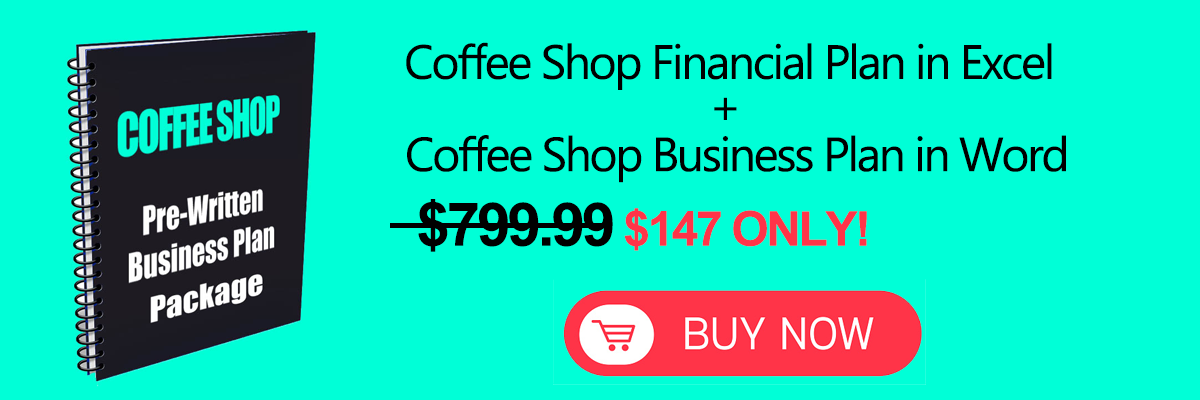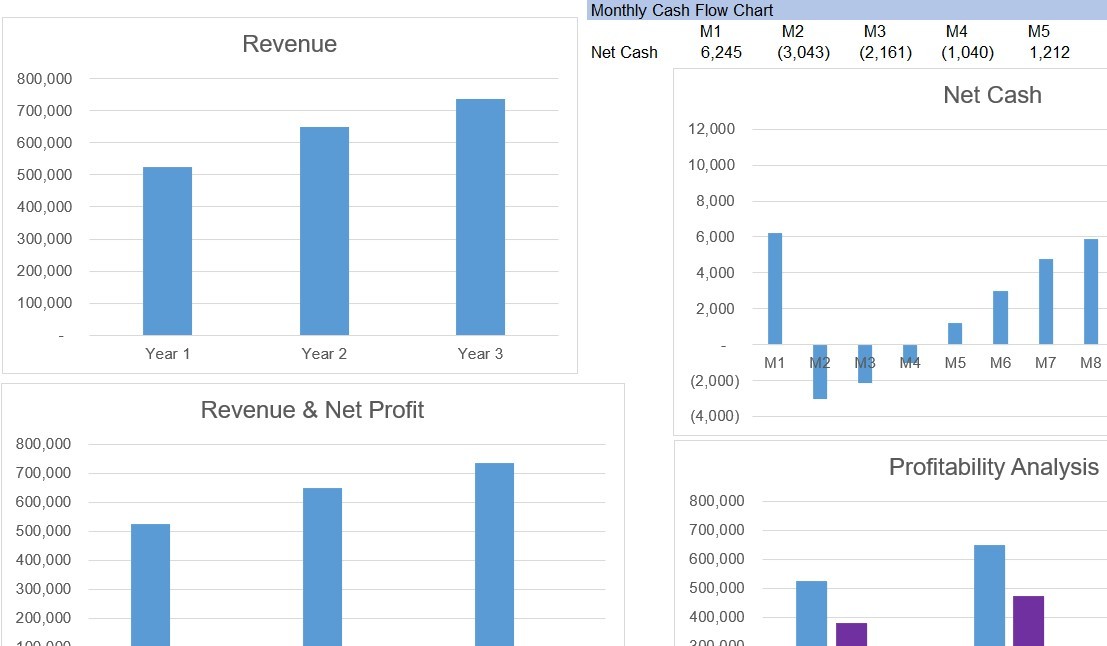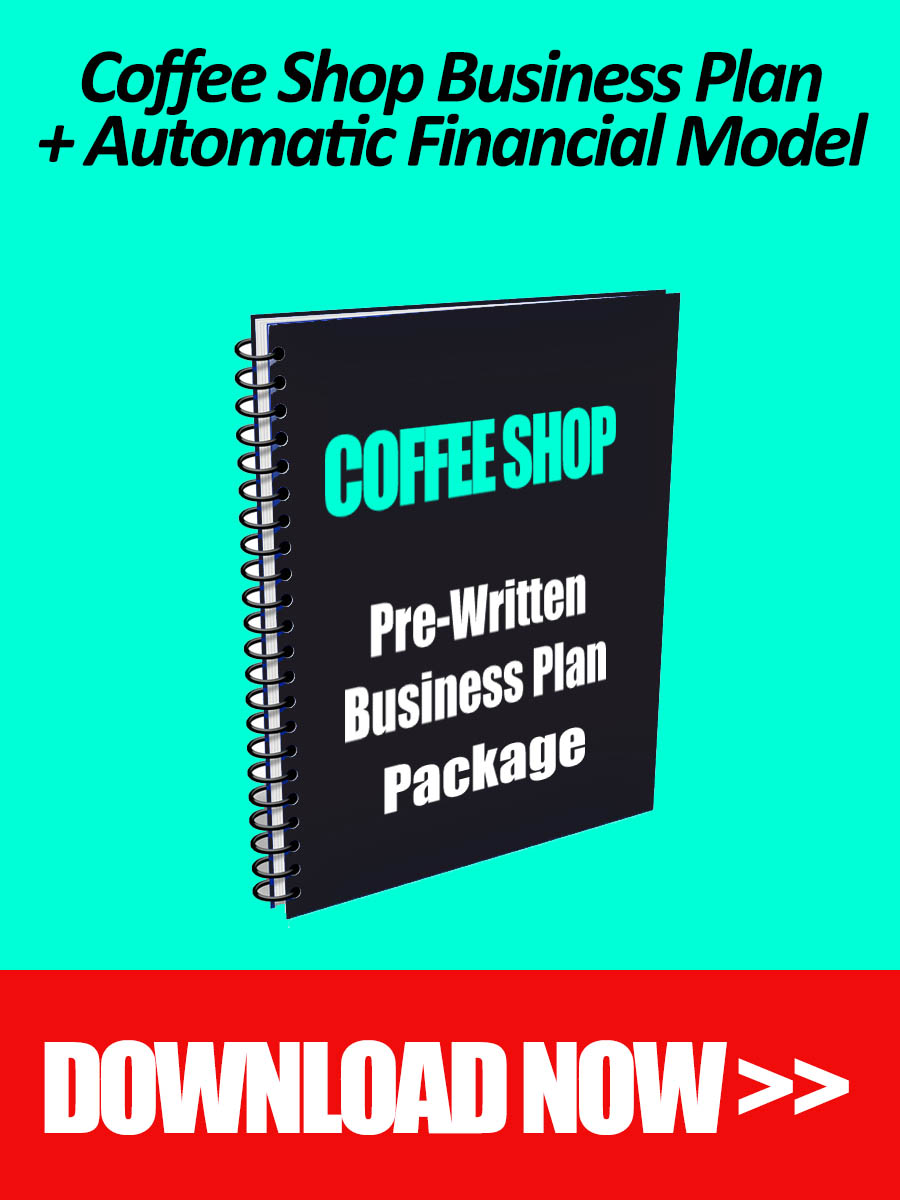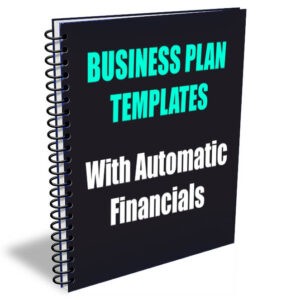If you are planning to launch a Coffee Shop or if you are currently in the process of developing a Coffee Shop business plan, you are probably thinking how to build a robust Coffee Shop financial plan allowing you to better understand the business opportunity from a financial and economic perspective.
Moreover, if you are planning to raise funding for your Coffee Shop venture or simply wish to invite in a partner, a Coffee Shop financial plan and model is a must to be able to properly gauge the opportunity and make a strong case.
Coffee Shop Financial Plan Excel Template
Before we dive in our detailed guide that explains what to include in your Coffee Shop Financial Plan, you might be interested to check our Coffee Shop Business Plan Template that includes an automatic and fully customizable pro-forma financial model in Excel Spreadsheet tailored to the Coffee Shop business. Below are a couple of screenshots to give you an idea.
You don’t need any advanced accounting or financial knowledge to use or understand the Excel Spreadsheet financial plan, all you have to do is adjust a number of cost and revenue assumptions to fit your own Coffee Shop project and the model will automatically generate for you key financial statements and including Profit & Loss statement, Cash Flow statement and Balance Sheet, in addition to a number of important charts and tables.
Now without further ado, let us explain the main components of a solid Coffee Shop Financial Plan. You can watch the video below to start with then read our full and detailed guide to properly digest the concepts.
Coffee Shop Financial Plan: Costs Forecast
The first step in understanding your Coffee Shop business opportunity is to understand the cost involved in launching such a venture.
Understanding Your Coffee Shop Monthly Expenses
Your coffee shop’s monthly expenses or cost figures are usually divided into two categories: Costs Of Goods Sold (COGS or Direct Costs) and Operating Expenses (Opex) that usually include Sales, General and Administrative expenses.
Let us first understand the direct costs involved in a Coffee Shop business. Typically, these costs include the cost of purchasing raw materials to prepare your coffee drinks, such as: Coffee beans, sugar, milk…etc. They also include anything you pay third-party external suppliers for goods you don’t prepare yourself and that you resell to your customers such as: Cakes, pastries, sandwiches…etc.
Now with regards to operating expenses involved in a Coffee Shop business, these typically include the salaries you pay your staff, your marketing and advertising expenses, your rent, utilities, phone, internet, licensing costs…etc. These expenses are crucial to help you run and promote your Coffee Shop and hence we call them operating expenses.
By adding your COGS and Operating Expenses, you can then estimate the total costs involved in running a Coffee Shop business.
Remember that some cost items go up over time. For example, salaries usually tend to go up because you will not only increase your existing employees’ annual compensation but also hire additional staff if the business requires so. Other costs tend to remain relatively stable such as you rent, you monthly utilities bill…etc.
It is very important to forecast these changes in cost while you are building your cost model.
Coffee Shop Financial Plan: Capital Expenditures
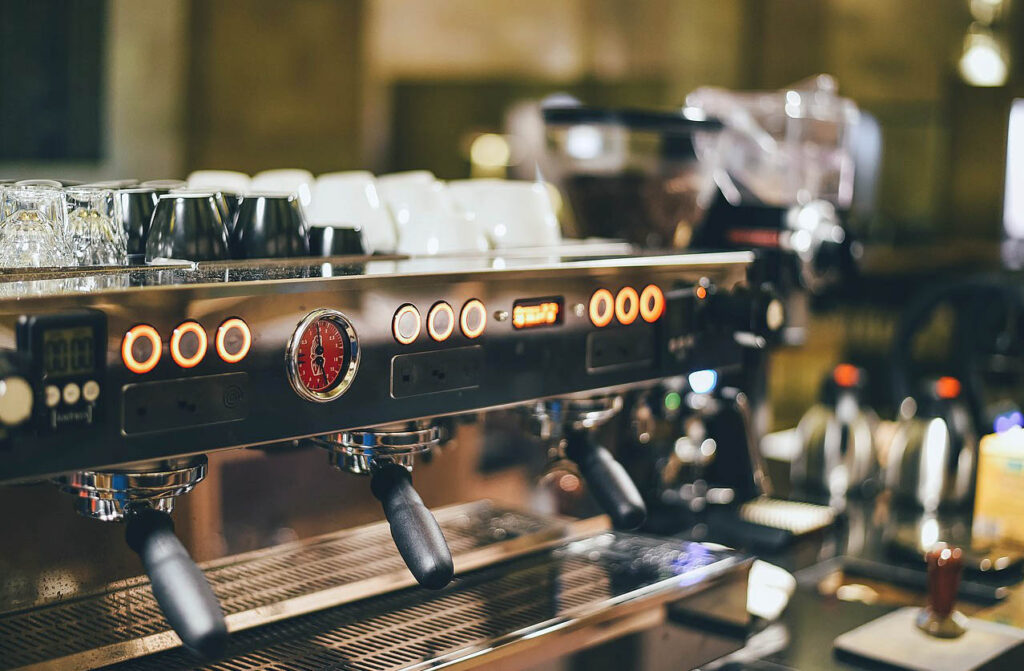
Next, we need to understand the capital expenditures involved in launching a Coffee Shop business. But let us first explain what capital expenditures are and how they differ from operating and direct costs. Simply put, a capital expenditure also called Capex, is any investment you incur to purchase a valuable equipment or long-term asset such as an expensive espresso machine, furniture for the venue or an IT system.
These are long-term assets that are used for many years and hence instead of expensing them, accountants usually depreciate them for the duration of the project or depending on current best practices (for example, a company vehicle is usually depreciated for a longer time than an IT terminal).
With regards to your Coffee Shop project, examples of capital expenditures (or Capex) include: Coffee-making equipment, venue furniture and decoration, IT and security system…etc.
Coffee Shop Financial Plan: Startup Costs
Now that we have seen the different types of costs involved in launching a Coffee Shop, it is time to evaluate our startup costs. The startup costs related to your coffee shop are simply all the pre-operating expenses and investments you need to make before your business starts to generate revenue.
For example, getting a business license, paying to develop your brand identity or purchasing a professional espresso machine are all expenses you need to incur before your coffee shop is operational. Make sure you jot down all the expenses you believe you need to pay for prior to launching your business. Your total startup costs should be usually covered by your initial capital.
Coffee Shop Financial Plan: Revenue Forecast

After modeling your costs, it is time to forecast your revenues. This step is usually trickier than estimating costs because it involves making many assumptions such as number of customers, frequency of orders, average order values…etc. However, by carefully analyzing your sector and business model, you can make educated assumptions that can greatly reduce your margins of error.
For example, to estimate your number of daily customers, you can look at the number of people in a certain age tranche, living in your neighborhood, and start making assumptions based on that. Let’s take an example:
Suppose there are 10,000 young adults between the age of 18 and 35 living in your vicinity, and let’s assume that only 5% of them will visit your coffee shop at least once a month (some will visit almost every day, some will visit weekly and some others only 1 time per month); this works out to 500 regular monthly customers. Now if we assume that each customer will visit the coffee shop twice a month on average, and if we assume the average order value per customer to be around 10 USD, this implies a monthly estimated revenue of 500 x 2 x 10 = 10,000 USD. Now that you have estimated the revenue for one month, you can easily forecast your annual revenue. But of course make sure to also take into account the seasonality (for example, during summer time, your customers might leave the town to go on holidays and this might reduce your average monthly revenue in July and August…etc.)
The purpose is to build a revenue model that is as close to reality as possible and one way to do that is to be as conservative as possible. By conservative we mean: Don’t go overboard with the number of expected customers, their frequency of ordering or the average spending per customer. Always use reasonable assumptions that make sense and that are backed with some reliable statistics or data whenever possible.
Coffee Shop Financial Plan Sample: Income Statement or Profit & Loss
Now that you have modeled your Coffee Shop’s cost and revenue, it is time to project your income statement, also called profit and loss statement of P&L. To start off, check the P&L example taken from a coffee shop financial plan sample below.

Understanding Your Coffee Shop’s Profitability
So, to simplify things, you can think of the income statement as a series of subtractions applied to your revenue to find out how much profits your business has really created. Then, if you divide your net profit by your revenue, you get your net margin. The higher the net margin the higher your coffee shop’s profitability.
By using our Coffee Shop Financial model included with our premium business plan template, you don’t need to worry about building a P&L statement from scratch. This financial statement is automatically generated once you edit your cost and revenue assumptions, hassle-free.
Coffee Shop Financial Plan Sample: Cash Flow Statement
The statement of cash flows is, as its name indicates, a summary of the cash movements happening in your coffee shop business over a certain period of time. Check the cash flow statement below taken from a coffee shop financial plan sample.
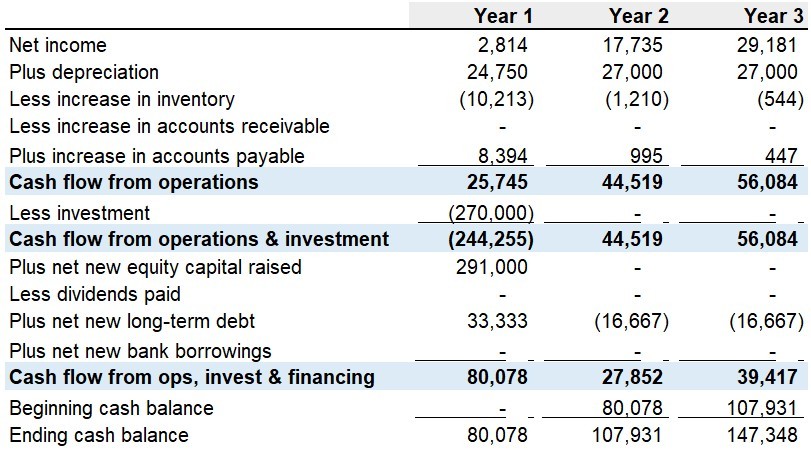
First, let us explain the difference between cash and income as many people tend to confound both. The main difference between a cash-flow and an income is timing. To understand the nuance, let’s take a general example from the consulting industry: Suppose you sent an invoice of 1,000 USD, dated March 15th, to your client after completing a consulting project. Your client receives the invoice and then calls you to confirm he will pay his dues during the first week of April. Comes April, you check your bank account, and you notice indeed a wire transfer of 1,000 USD dated April 5th.
So, what did actually happen? Accounting wise, you should record 1,000 USD as a revenue for the month of March in your income statement, while you should record 1,000 USD as a cash inflow for the month of April in your cash flow statement. This means that cash flows do not necessarily follow the same recording date of income and payments. Income and expenses usually follow the invoice date while cash inflows and outflows follow the actual clearing or payment date.
So what is the cash flow statement comprised of?
It is simply the summary of three types of cash flow movements over a certain period of time:
The cash flows from operating activities: Here, cash inflows are money collected from customer orders and cash outflows are payments made to pay for COGS, raw materials and external suppliers.
The cash flows from investing activities: Here, cash inflows are money collected from the sale of a certain asset or capex item (such as an old espresso machine) and cash outflows are money paid to acquire new assets (such as a new espresso machine).
The cash flows from financing activities: Here, cash inflows are new funding received from business loans or equity investors and cash outflows are payments made to partners in the form of dividends for example.
Investors focus a lot on the ability of a business to generate solid and tangible cash flows which means that it is not enough to have a profitable coffee shop, what’s even more important is to grow an F&B venture that generates consistent and significant cash flows.
If you use our Coffee Shop Financial plan in Excel included in our premium Coffee Shop Business Plan package, you will be able to automatically generate a detailed cashflow statement after updating your cost and revenue assumptions.
Coffee Shop Financial Plan: Balance Sheet
The balance sheet is another important financial statement. It summarizes the assets and liabilities of your coffee shop at a certain point in time (typically at the end of the year).
The balance sheet is divided in two sections. The first one lists all your short-term assets (cash and equivalents, inventory, receivables…etc.) and long-term assets (property, plant and equipment less accumulated depreciation…etc.)
The second section lists all your current liabilities (account payable, bank notes payable…etc.), long-term liabilities (bank debt, business loan…etc.) and shareholder’s equity.
The balance sheet can be summarized using the following formula:
Assets = Liabilities + Equity
By using our Excel Coffee Shop Financial plan included in our premium Coffee Shop Business Plan package, you will be able to automatically generate a detailed balance sheet after updating your cost and revenue assumptions.
Coffee Shop Financial Plan: Conclusion
This guide has provided you with a general overview of how to build an effective financial plan for your Coffee Shop project. Remember that a serious Coffee Shop business plan must include a solid financial plan with robust cost and revenue models. You can totally build this from scratch. But if you are short on time and wish to avoid potential mistakes, we highly recommend you use our detailed Excel financial model Spreadsheet included in our Coffee Shop Business Plan template.


